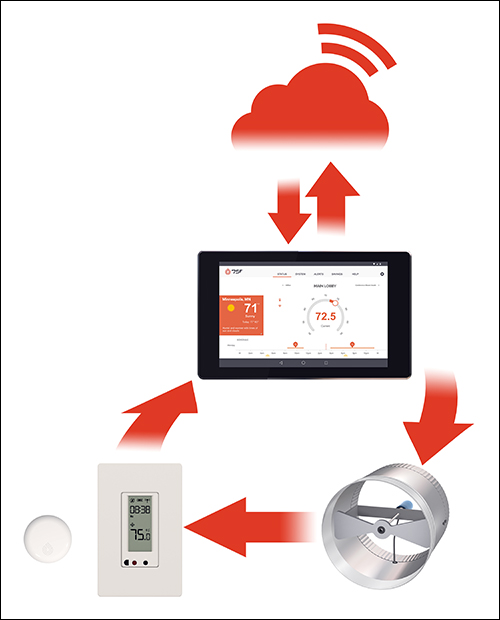Yoga is all about balance and awareness, and about being in tune with nature. Right? Not exactly, explains Deepinder Singh, CEO of 75F, a Minneapolis-based company that sells a smart heating, ventilation and air-conditioning (HVAC) system. “It’s such an energy waster,” he says.
To be clear, Singh is not trash-talking yoga itself, but rather the practice of heating yoga studios to as high as a sweltering 90 degrees Fahrenheit (32 degrees Celsius) for certain types of classes, as is generally done for Bikram yoga or derivatives of that style. This is especially true in Minnesota, during winter.
Let’s step back 10 years. Singh, then a new father working as a software engineer in Minnesota, noticed that his daughter’s bedroom was cold and that this was causing her to awaken during the night. “The temperature dropped about 10 degrees in her room at night,” he says. He quickly realized the cause: the thermostat was located in the master bedroom, which faces west and receives more heat from the sun during the day.
Singh saw an opportunity. If HVAC systems where designed differently to account for the shifting radiation patterns throughout a building, he realized, they could ensure more even temperature distribution. He thus quit his job and launched a company known as Suntulit, which developed remotely controllable vent covers designed to maintain each room within a house at a set temperature, based on a daily schedule established by the homeowner.
But by 2012, Suntulit had not yet brought its product to market (a company called Ecovent has since released a similar solution), and Singh decided to pivot, opting to start 75F, a firm that would instead focus on innovating HVAC systems for small to midsize commercial spaces, since that, he says, is a large and untapped market. High-rise office buildings generally have sophisticated HVAC systems, Singh explains, but that is not always true of small- or medium-sized commercial buildings—those measuring 50,000 square feet or less in size—which make up 94 percent of the commercial building real estate market, according to the U.S. Energy Information Administration.
75F’s eponymous product uses proprietary dampers wired to a monitor in each room. Those monitors contain temperature, humidity, carbon dioxide and occupancy sensors, and communicate those readings to a central control gateway in the building, via a proprietary 900 MHz radio, every 60 seconds. The gateway is connected to the Internet and controlled by 75F’s cloud-based software platform.
When the system is installed within a building, the geographic location and orientation to the sun are entered into 75F’s Web-based platform. Each night, the company’s cloud-based software takes this information into account, along with the next day’s weather forecast, and issues instructions to the central control gateway regarding how and when to set each room’s temperature, based on commands to the room-level controllers (which control the damper in that room’s vent). The building manager can then set a temperature schedule for the building—and for specific rooms within it, if desired—via 75F’s platform.
Throughout the day, the gateway instructs the dampers when to open or close, based on the real-time temperature inside each room. The system is also programmed so that fresh air is brought in from the outside only when needed, based on each room’s CO2 readings. Conversely, if a particular room needs to be cooled quickly during cool months—perhaps because many people have entered and raised the temperature, or due to a change in the expected weather—the system will let in additional outside air, rather than relying on chillers to lower the temperature. Conventional HVAC systems regularly bring in fresh air regardless of need, which means they also need to heat or cool the air per the set temperature, requiring more energy than 75F’s system.
Now, back to yoga. YogaFit Studios is a nationwide chain of yoga studios, and the one located in the Linden Hills neighborhood of Minneapolis is among 75F’s customers. “We’ve probably saved about 20 percent of the energy we used to use,” says Ashok Dhariwal, the studio’s co-owner. However, he adds, the bigger benefit is that the studio’s temperature is now automatically set, whereas before the 75F system was installed, every class instructor would set the room’s temperature at the beginning of his or her class. As a result, the room would often be too warm or two chilly for the next class, and would not hit the desired temperature until well into class time.
YogaFit’s instructors set the room’s temperature when they set the class schedule in Google Calendar, from which the 75F cloud-based software can then pull that information. Now, Dhariwal says, the studio is always at the desired temperature at the beginning of every class. “And it is Internet-based, so if a class is cancelled, I can log in and change the temperature so the room is not heated,” he adds, referring to 75F’s Facilisight Web-based app, which is available on both iOS and Android operating systems.
The expected return on investment for the 75F system is three years, according to Singh, but it can vary widely based on the number of rooms inside a building, as well as the availability of rebates for energy savings. “We have a client who got a discount from Xcel, its local utility,” he states, “and, based on that, we expect it will see a return on investment in less than a year.”
The system costs roughly $3.00 to $3.50 per square foot to install within a typical small to midsize commercial building, though for buildings without many individual spaces to monitor, such as retail spaces or yoga studios, installation costs are lower. However, Singh notes, spaces such as retail stores or fitness studios may also require more energy to heat or cool, simply because their interior rooms are larger. In buildings that must heat or cool large rooms or spaces, owners might see an energy savings of 25 to 30 percent, he predicts, while those with more individual spaces, such as office buildings, can attain a 40 percent energy savings.



